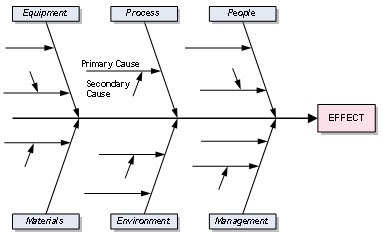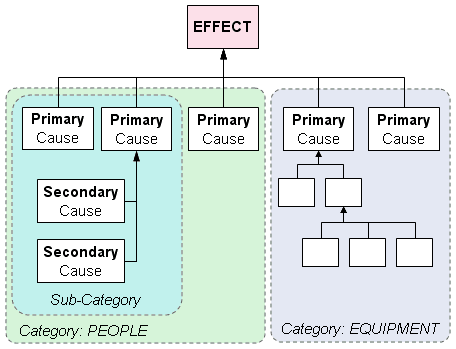Draw Cause and Effect Diagram Online
A Fishbone Diagram is some other name for the Ishikawa Diagram or Crusade and Effect Diagram. It gets its proper noun from the fact that the shape looks a bit like a fish skeleton. A fish bone diagram is a common tool used for a cause and outcome assay, where you endeavor to place possible causes for a sure trouble or outcome. The following downloads may assist you lot get started, and if you go on reading, I've included some detailed information about how to utilize the diagrams.
Advertizement
Printable Fishbone Diagram / Cause and Effect Diagram
The following crusade and effect worksheets are PDF files that y'all tin can download and impress from instantly.
Fishbone Diagram Template
for Excel and OpenOffice

Download
⤓ Excel (.xlsx)
For: Excel 2007 or later & Excel for iPad/iPhone
Other Versions
License: Individual Use (not for distribution or resale)
"No installation, no macros - just a simple spreadsheet" - by
Description
Create a cause and effect diagram with a spreadsheet. Although not angled like most fishbone diagrams, this template is very simple to edit and customize (as opposed to constantly moving and aligning text boxes and arrows).
- Use cell formatting to add together/remove branches to the diagram.
- Insert rows to increase space for master causes.
- Employ text indenting within a cell for secondary or tertiary causes
- Copy and paste columns to insert more categories.
The Outline worksheet included in the workbook (screenshot not shown) is even simpler to use. It organizes the diagram into an outline view that is much easier to edit on the wing.
Using a Crusade and Upshot Diagram
The purpose of a cause and effect analysis is to place the causes, factors, or sources of variation that lead to a specific event, result, or defect in a product or process. A fishbone diagram is merely a tool to be used along with Brainstorming and the 5 Whys.
The various causes are grouped into categories and the arrows in the image beneath indicate how the causes cascade or menstruum toward the terminate effect. Due to its simplicity, the diagram is often fatigued on a white board during a brainstorm session. I designed the above template so that it would easy for someone familiar with Excel to use during a coming together to record the ideas every bit they are discussed.

Steps to Using a Cause and Event Diagram
- Define the Consequence: Be specific.
- Cull Categories: The template is prepare with the near mutual ready of categories, but you lot can add or remove categories based on your specific example. Come across the example categories below.
- Brainstorm Possible Causes: Using the diagram while brainstorming can both broaden and focus your thinking as y'all consider the various categories in turn.
- Inquire Why?: Y'all really want to observe the root causes, and ane fashion to assistance do that is to use the 5 Whys technique: asking "Why?" or "Why else?" over and over until you come upward with possible root causes. "Improper handling" is not a root cause, while "Failing to wearable Latex gloves" might be closer to a root cause. Simply, you could all the same ask "Why was he/she not wearing gloves?" with the possible response "There were none available." It is a lot easier to take action against the inventory problem than just the generic "improper handling".
- Investigate: At present that you've come up up with possible causes, it is time to go gather information to confirm which causes are real or not.
Common Categories in a Fishbone Diagram
| The M's | The P's (Service Manufacture) | The S'southward (Service Manufacture) |
|---|---|---|
| Machine (Equipment) Method (Process) Homo Power (People / physical labor) Cloth Mother Nature (Surroundings) Management (Policies) Measurement (Inspection) Maintenance Marketing (Promotion) | Establish/Place Process People Policies Procedures Price Promotion Product | Environment Supplies Systems Skills |
Categorization vs. Causality
During a brainstorm session, this diagram is usually used very loosely, meaning that sometimes branches (what I take labeled every bit principal and secondary causes in the diagram below) may actually stand for sub-categories of causes rather than bodily causality.
When a cause and outcome diagram is used to correspond causality , then the primary and secondary branches taken on very specific meanings:
A Primary Cause is one that could lead directly to the upshot. For example, a low-cal bulb that burns out pre-maturely (the result) might be caused past a sudden jarring motion such as dropping, which might be listed under the category People if it was associated with handling by a person (every bit opposed to auto treatment).
A Secondary Cause is a cause that could lead to a Primary Cause, but does non directly cause the cease effect. For instance, the cause glace easily doesn't make the bulb fire out, merely it could lead to the light bulb being dropped. So slippery hands would be listed equally a secondary crusade under dropping.
When a fishbone diagram is used for just categorizing possible causes, then instead of listing Dropping in the place of a primary cause, it might be listed under the sub-category Improper Handling, with Dropping and Throwing as different causes that fit under that sub-category. The post-obit instance shows the sub-categories highlighted.
Effect: Calorie-free Bulb Burning Out Prematurely
| Causality Approach | Categorization Approach | Combination |
|---|---|---|
| People > Dropping > > Slippery Easily > > Rolling off a Table > Throwing | People > Improper Treatment > > Dropping > > Throwing | People > Improper Handling > > Dropping > > > Glace Hands > > > Rolling off a Table > > Throwing |
A tree diagram, probability tree, or root cause analysis is geared more towards thinking in terms of causality, while using a fishbone diagram tends to make people recall in terms of categorization. Using the fish bone diagram loosely may result in a combination of the 2 approaches every bit the grouping oscillates betwixt categorizing unlike causes and asking "Why?" or "Why else?".
Although I've never seen any reference for this technique, I use the following rule to distinguish between categorization vs. causality:
Just as the main categories (Equipment, People, etc.) are highlighted by placing a circle or box effectually them, if you lot include sub-categories in your cause-and-effect diagram, circle the sub-category so you can distinguish between categorization vs. causality.
The following tree diagram shows the departure between categorization (grouping of causes) and causality (the tree).

Related Content
More Quality Management Resources
- Control Chart - past Vertex42.com - Hands create an Xbar-R command chart for a process.
- Pareto Chart - by Vertex42.com - Perform a pareto analysis (visualize the ranking of most significant factors)
Follow Us On ...
Source: https://www.vertex42.com/ExcelTemplates/fishbone-diagram.html
0 Response to "Draw Cause and Effect Diagram Online"
Post a Comment